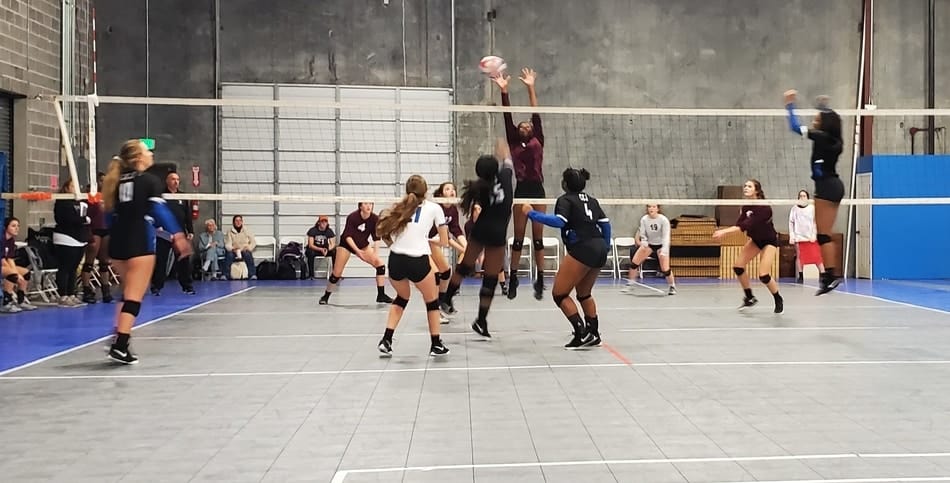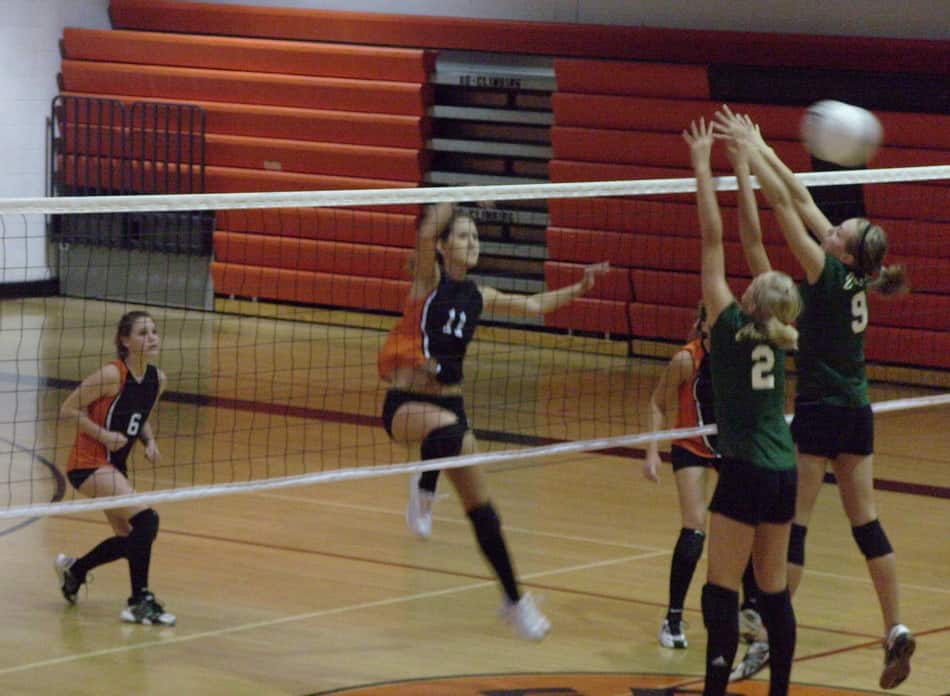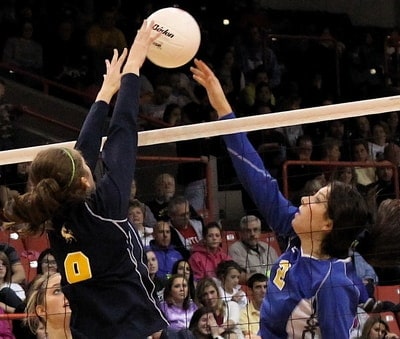There are so many different rules when you first start watching or playing a new sport, it can be pretty overwhelming. If you’re new to volleyball, it’s pretty common to see a coach get very upset with their team and not be clear about why.
In volleyball, do you have to hit the ball 3 times before hitting it to the other side? No, your team is allowed to hit it up to 3 times, but it’s perfectly legal to hit it over with just 1 or 2 hits.
So you’re probably wondering, then why does my coach make a big deal about using all 3 hits? Why does it look like a team hit it more than 3 times sometimes?

Why Does My Coach Get So Upset When We Don’t Use 3 Hits?
When you’re new to the sport and you’re just wanting to win, it can be very confusing and frustrating when a coach doesn’t seem happy (or may get even downright mad at their team) when your team puts the ball over the net and you won the point. After all, isn’t that the whole point? But the truth is your coach SHOULD be upset under many circumstances when your team is not using all 3 hits, and in this article, I’m going to explain why.
Your Coach Is Focused On Good Fundamentals
If you’re frustrated with your coach, take a breather and read with me for a few minutes. Let me tell you the most important thing for you to understand: Your coach is trying to teach you or your player GOOD FUNDAMENTAL volleyball, and that is often NOT the easy thing.
When my daughter Heidie was playing on her 12’s team I remember we had a team full of bumpers. They could all bump the ball all day long and just have a great old time. I say bump because there weren’t even trying to pass the ball to someone, in particular, they were just bumping it up and usually right over the net.
While they weren’t playing well, they didn’t seem terrible either. As parents, it seemed like our coach was focusing on the wrong thing and being very critical of the kids when it didn’t matter.
“So what’s wrong with bumping it over? My kid is 11 years old and if we just bump it over, we usually win the point.” Those words you just read – came out of my own mouth. I’d heard other parents mutter the same thing under their breath and I’m a pretty direct person, so I asked the coach 1 on 1 when no one else was around to hear.
That wonderful, patient coach smiled, looked down at the floor, and said: “Do you trust me?” Of course, I did, she seemed to have really high standards and she was great with the kids. “Let me coach your daughter and her team to do it right, and by the end of the season I won’t even have to explain it to you, you’ll get it.”
She was exactly right. We lost a lot of points throughout that season as we learned what it meant to play all 3 hits, but that team grew the most in 1 season than I’ve ever seen. Those points that we lost here and there as we learned how to play at a higher level were a very low price to pay for the growth our players experienced.
Good Fundamental Volleyball Relies On An Offensive Attack
Have you ever noticed when the ball comes high over the net, sometimes you’ll hear the players call out, “FREE”? The term freeball is anytime the ball comes over the net in a non-offensive way. When the other team isn’t attacking, but just trying to play it over, that’s a freeball.
When you hear them yell “FREE” there’s a meaning and message ingrained in these players.
A freeball is a free chance, a free opportunity. The other team is giving us an easy shot and we need to take advantage. We have a FREE shot to win this point, we just have to take it!

Good teams play smart, strategic plays that attack the other team, trying to put the ball on the floor. They don’t ever send the ball over on purpose without some speed or angle or ball placement that’s designed to attack the other team.
So the decision to use all 3 hits is a decision to be strategic. It’s a decision to play with a goal and a purpose. When you see the team that lifts the trophy at the end of the season or a tournament, you’re usually looking at the team that was number 1 at executing an offensive attack.
Players Need To Fight The Urge To Do The Easy Thing In The Heat Of The Moment
In the early years and even at higher levels when you’re playing a team that’s much stronger than your team, it’s difficult to have the control to keep the ball and set it up. When you’re struggling, it can seem like a better play to just put the ball on the other side of the net and hope the other team messes up.
Many players and teams make that choice and sometimes it works out…in the short run. What I mean is if you do this, you’ll win some points here and there, but the truth is your team will never be very strong playing this way.
Having the self-control to pass the ball, set it up to your teammate, and then attack in a powerful way, THAT is what is going to help your team long-term. As a coach, as a parent, or as a player, you should always encourage your team to be using 3 hits to play the ball every time you can.
Are There Exceptions To Trying To Use All 3 Hits?
There are exceptions to almost every strategy in sports and this one is no different. There may be more, but these are the exceptions that I think of:
First Contact of a Hard Driven Ball
Whether it’s on a crazy-good serve or a spike, the first contact may play the ball over the net. As you reach higher levels of play, your coach will expect defensive players to know how to handle these hard-driven balls and pass them effectively.
Once you reach varsity high school volleyball, the players who are receiving the serve (the defense), should be capable of keeping the ball on your side of the net pretty much every time. Every once in a while you’ll see someone let the ball go a little too far – what we call an overpass – and the other team will definitely look for the opportunity to spike the ball down in your face.

When you’re digging the other team’s hits, your coach will usually understand if you can’t control it quite as well. They expect you to get to it, they expect you to get your hands together and use your arms to make a good platform pass. They hope you can keep it under control.
So always do your best to try to dig or receive the ball by making a good, clean pass to your setter, but in some of these cases, your coach will let it go when you end up playing the ball over the net.
Do you know what the terms varsity and junior varsity mean? If not, check out this article I wrote for another website: What Varsity Means In Sports.
Surprise Aggressive Play
When you reach the high school level and in some competitive clubs and areas of the country even younger age groups, the attacks become very consistent and predictable. Especially when teams are evenly matched or when they play each other multiple times, the blockers from the other team may be having a very easy time predicting your plays and knowing where to block.
For this reason, a clever setter will carefully choose a time when the blockers are ready and waiting for their attacker and instead of setting the ball to the hitter, they’ll dump it (or set it with a very low arc) to an open area of the opponents’ court.
This play doesn’t work over and over so use it wisely. If you do it too often the other team will expect it and it just becomes a freeball for them. A really cool move that you rarely see is a backset used to dump it, that’s a crazy surprise to the other team!
A Two-Hit Attack
In rare cases, you may have a chance to mount a 2-hit attack and throw the other team off by pushing the pace of the game. This will almost never be a planned play, but instead an opportunity that just presents itself to players who are aware.
Sometimes the setter may receive a freeball and just decide to go ahead and set on the first touch. If you have one hitter that’s ready and aware, make sure to call to them so they don’t hesitate, but go for the kill!
Sometimes a dig will just happen to end up being right in the range where a hitter can use it to attack. It’s a challenging play to take that from so far away, but some hitters do it. They have to be very good at timing and tracking the ball, but the benefit is the other team will almost never be ready to block.
Totally Busted Play
If your team is in absolute scramble mode, sometimes the only right move is to play the ball over. I’m sure most coaches would cringe just reading those words, but those situations happen sometimes.
If your middle blocker lost their balance and knocked over your outside hitter while your libero and defensive specialist collided trying to dig the ball, they popped it up and you’re the only one who can get to it and the only teammate you have standing that you could try to set is your 5-foot-flat setter who is running toward you. It’s time to play the ball over.
One good rule of thumb is if you’re going to give the other team a freeball, make it as high and as deep as you safely can. That way your team has an extra few seconds to gather themselves and get in position. There’s also the off-chance that they are caught surprised that you played it to the back corner and they let it drop.
Why Does It Look Like The Other Team Had 4 Hits And It Wasn’t Called?
In indoor volleyball, the block doesn’t count as a hit. When the blockers touch the ball, it doesn’t count in any way against them except if it goes out of bounds on either side of the court (in which case it is called out on them).

Nearly every volleyball game I watch, it will happen at least once, there will be an intense play where the blocker touches the ball but it comes over, the team plays it in 3 and then some upset fan gets all irate that they used 4 hits.
Since the blocker’s touch doesn’t count as a hit, your team still has all 3 touches to use when the ball keeps coming. Whether the fans understand it or not, the referee knows the rules and you can take your time and plan an attack with your regular 3 touches.
Have you ever had questions about the referees and line judges in volleyball? Learn all about the volleyball officials in this article.
Can The Same Player Hit The Ball Twice In A Row?
The only time it’s okay for a player to hit the ball twice in a row is when they block the ball and then hit it again right after. Otherwise, consecutive hits are against the rules and you will be called for it.
When a blocker is blocking the ball, it may go up in the air or just drop near them and they are allowed to play it again. If 2 blockers simultaneously touch the ball, either one is allowed to make the next hit.
Related Questions:
What Are The 3 Hits In Volleyball?
When people think about the 3 types of hits in volleyball, they’re thinking about the bump, the volley, and the spike. In more modern terms, you will hear players say “pass, set, kill.”
Find out what that means and why they call it that here: The 3 Types of Hits in Volleyball
Can You Block or Spike The Serve?
This is a very common question because when players are serving very aggressively and keep the ball very close to the net, it really is possible to attack the serve before it’s really even on your side of the net. The quick answer is no, you are not allowed to block or spike the serve.
To learn all about this rule and why it exists, check out this article: Blocking Or Spiking The Serve In Volleyball.
Photo Credits:
Feature image by Keith Johnston from Pixabay
Player #11 attack image by Lauren on flickr.com: https://creativecommons.org/licenses/by/2.0/, cropped to zoom in.
Black and blue blocking image by Battle Creek CVB on flickr.com: https://creativecommons.org/licenses/by/2.0/, cropped to center.
Recent Posts
Athletes, listen up! Do you have a closet full of old jerseys, sweatpants, and tees that you just can't seem to part with? Well, dust them off, because you're sitting on a goldmine of fashion...
You may have heard, or you may have noticed, that there's been a change to the rule about double contact in volleyball. In 2022, an experimental rule change began to be implemented, where the double...
